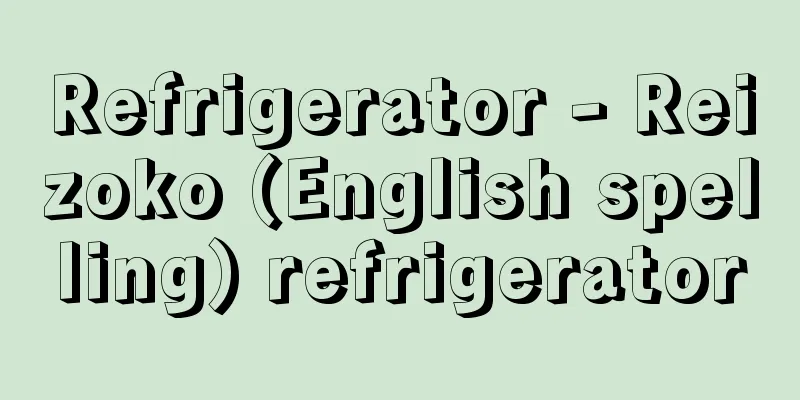Refrigerator - Reizoko (English spelling) refrigerator

|
A device that can keep the temperature of the storage area low in order to store food. Classified by cooling method, there are (1) ice refrigerators and ice boxes that use the heat of melting ice, (2) electric refrigerators and gas refrigerators that use the heat of evaporation of liquid, and (3) electronic refrigerators that use the Peltier effect (the phenomenon in which when two ends of different metals are connected and an electric current is passed through the connection, one side generates heat and the other side absorbs heat). Nowadays, when people talk about refrigerators, they generally mean electric refrigerators. [Eiichi Komagata] Ice refrigeratorThe use of natural snow and ice to preserve food is thought to have been done since ancient times, as the Nihon Shoki (Chronicles of Japan) (720) records that during the reign of Emperor Nintoku, Prince Nukata discovered an ice cave in the mountains of Izumi, and built an icehouse to use for cooling water and sake in the summer. Artificial ice was first made in Japan in 1877 (Meiji 10) in Osaka. Until then, in order to obtain ice outside of winter, natural ice made in the winter was stored in icehouses and transported in the summer. In 1883, an ice-making company was established in Tokyo. Then, in 1903 (Meiji 36), ice refrigerators appeared and began to be used at Tokyo's fish markets. Ice refrigerators for home use went on sale around 1907. In ice refrigerators, the temperature inside is around 15°C, and it is difficult to cool it below 10°C. In addition, ice must be replenished periodically. Ice refrigerators were used until the 1960s. Recently, ice boxes have come to be used for leisure purposes. [Eiichi Komagata] Electric refrigeratorIt was put to practical use in America in 1913 and imported to Japan in the 1920s. The first domestically produced electric refrigerator was released in 1930 (Showa 5), but it was expensive, costing over 700 yen, enough to buy a house. According to the JIS (Japanese Industrial Standards), a refrigerator is one that is cooled by an electrically powered compression freezer and has one or more storage compartments (called refrigeration compartments) that can maintain the temperature required for storing foods other than frozen foods, while a refrigerator-freezer is one that has one or more refrigeration compartments and also one or more storage compartments (called freezer compartments) that can maintain the temperature required for storing frozen foods, and the collective term for these is an electric refrigerator. The principle of an electric refrigerator is to utilize the heat of vaporization when a liquid evaporates. The liquid (refrigerant) used for this was generally fluorocarbon gas (dichlorodifluoromethane), but its use was banned due to the problem of ozone layer destruction, and substitute fluorocarbons such as HFCs (hydrofluorocarbons) are now used. It was found that substitute fluorocarbons also have a very high greenhouse effect, so non-fluorocarbon refrigerants have come to be used. The structure of an electric refrigerator consists of a compression refrigerator, a storage compartment, and an operation control device. The compression refrigerator compresses the refrigerant gas, liquefies it in the condenser, reduces the pressure of the liquefied refrigerant by passing it through a capillary tube, and evaporates it in the cooler. The storage compartment is a container for storing food, and insulation is placed between the inner box and the outer box to prevent the temperature inside the storage compartment cooled by the refrigerator from rising due to the outside air. The operation control device is a device for maintaining an appropriate temperature inside the storage compartment, and a temperature sensor is installed in each storage compartment, with the refrigerator compartment being able to be adjusted to around 3°C and the freezer compartment to around -18°C. When the refrigerator is in use, water vapor from the outside air that enters when the door is opened and closed, and water vapor that evaporates from the food in the storage compartment, forms frost on the cooler and adheres to the compartment, causing the cooling inside to deteriorate. The device that removes this frost is called the defroster, and can be automatic or manual, using a dial or push button. There are two types of cooling methods for refrigerators: natural convection, and forced circulation, which uses a fan. The most common type of refrigerator-freezer is a two-door type with a door for each compartment, but three-door or even more types have appeared to accommodate the increasing size of refrigerator-freezers and to make them easier to use. The performance of the freezer compartment of a refrigerator-freezer is specified by the JIS and is regulated by the average freezing load temperature. In other words, assuming that the temperature of the refrigerator compartment does not fall below 0°C, there are three categories of freezer load temperatures: -18°C or less, -15°C or less, and -12°C or less, and each is represented by a symbol. The symbols are called "three star," "high two star," and "two star." A freezer that can freeze more than 4.5 kilograms of food per 100 liters of freezer capacity to -18°C or less within 24 hours is called a "four star." The shelf life of frozen foods cannot be generally determined, as it depends on the type of food, the freezing method, and the history of the food before freezing, but as a general guideline, Four Star and Three Star foods can last for about three months, High Two Star for about 1.8 months, and Two Star for about one month. When installing an electric refrigerator, choose a location that is not exposed to direct sunlight, away from heat-generating appliances such as gas stoves, and where it will not get wet and is low in humidity. It is also important to be careful not to impede the heat dissipation of the condenser. To prevent the temperature of food inside the refrigerator from rising and to save electrical energy, do not pack it with too much food or put hot food in it. It is also important to be careful not to open and close the door unnecessarily or forget to close it. [Eiichi Komagata] Gas refrigeratorIt uses an absorption refrigerator that uses an aqueous ammonia solution as a refrigerant, heating the refrigerant with a gas burner to separate it into ammonia and water, and utilizing the heat of vaporization when the ammonia vaporizes. This type of gas refrigerator was invented in 1922 (Taisho 11) by Manter and Planten, who were students in Sweden at the time. In Japan, it was domestically produced in 1955 (Showa 30). Gas refrigerators are characterized by the absence of noise during use and the absence of breakdowns due to mechanical wear, but they have lagged far behind electric refrigerators in terms of popularity. [Eiichi Komagata] Electronic refrigeratorIt uses a Peltier element, which is made of n-type and p-type semiconductors connected by a copper plate. Compared to electric refrigerators, it has features such as less noise, a longer lifespan, and can be used for both heating and cooling because it becomes a heating element when the current direction is reversed. However, at present, it has the disadvantages of being expensive, inefficient, and vulnerable to sudden changes in temperature. For this reason, although it is sold for both commercial and household use, it has not yet become widespread. [Eiichi Komagata] [Reference items] | | | |©Takashi Aoki Principles of an electric refrigerator Ice is placed inside to cool the inside of the cabinet. It first appeared in 1903 (Meiji 36) and was used in stores and homes until the 1960s . It is still used today in sushi restaurants to prevent the items inside from drying out. Ice refrigerator Source: Shogakukan Encyclopedia Nipponica About Encyclopedia Nipponica Information | Legend |
|
食品を貯蔵するために、収容部の温度を低温度に保つことができる装置。冷却法により分類すると、(1)氷の融解熱を利用した氷冷蔵庫、アイスボックス、(2)液体の蒸発熱を利用した電気冷蔵庫、ガス冷蔵庫、(3)ペルチエ効果(異なった金属の両端を接続して電流を流すと、その接続部には、一方に発熱作用、他方に吸熱作用が起こる現象)を利用した電子式冷蔵庫などがある。現在では、一般に冷蔵庫といえば、電気冷蔵庫をさす。 [駒形栄一] 氷冷蔵庫食品の保存に天然の雪や氷を利用することは、古くから行われていたと思われ、『日本書紀』(720)には、仁徳(にんとく)天皇のとき額田の皇子が和泉(いずみ)の山中で氷窟(ひょうくつ)を発見し、氷室をつくって夏に水や酒を冷やすのに用いたという記述がある。 人造氷が日本で初めてつくられたのは、1877年(明治10)で、場所は大阪であった。それまで冬季以外に氷を得るためには、冬にできた天然の氷を氷室に保存し、夏季にそれを輸送したものである。1883年には東京にも製氷会社が発足した。そして、1903年(明治36)には氷冷蔵庫が出現し、東京の魚河岸(がし)で使われるようになった。家庭用の氷冷蔵庫は1907年ころに発売された。 氷冷蔵庫では、庫内の温度は15℃前後であり、10℃以下に冷やすことは困難であった。また、定期的に氷を補充する必要があった。氷冷蔵庫は1960年代まで使用された。最近ではレジャー用にアイスボックスが利用されるようになってきた。 [駒形栄一] 電気冷蔵庫1913年にアメリカで実用化され、20年代に日本に輸入された。国産第1号の電気冷蔵庫は、1930年(昭和5)に発売されたが、価格は700円以上で家が一軒買えるほど高価なものであった。 JIS(ジス)(日本工業規格)によれば、電気によって駆動される圧縮冷凍機によって冷却され、冷凍食品以外の食品を貯蔵するために必要な温度を保つことができる貯蔵室(冷蔵室という)が一つ以上あるものを冷蔵庫といい、冷蔵室を一つ以上もち、なおかつ冷凍食品を貯蔵するために必要な温度を保つことができる貯蔵室(冷凍室という)が一つ以上あるものを冷凍冷蔵庫といい、これらを総称したものが電気冷蔵庫である、ということになる。 電気冷蔵庫の原理は、液体が気化する際の気化熱を利用したもので、これに使用する液体(冷媒)は、一般にフロンガス(ジクロロジフルオロメタン)が使用されていたが、オゾン層破壊が問題となり、使用禁止となったため、代替フロンのHFC(ハイドロフルオロカーボン)などが用いられている。この代替フロンもきわめて高い温室効果をもたらす物質であることが判明したため、ノンフロン系の冷媒が使用されるようになってきた。電気冷蔵庫の構造は、圧縮式冷凍機、貯蔵室、運転制御装置からなっている。圧縮冷凍機は冷媒ガスを圧縮し、そのガスを凝縮器で液化させ、その液化冷媒を毛細管を通すことによって圧力を下げ、冷却器で蒸発させるという機能を連続的に行う。貯蔵室は食物を入れる容器で、冷凍機により冷却された貯蔵室内の温度が外気によって上昇しないように、内箱と外箱の間に断熱材を入れてある。運転制御装置は、貯蔵室内の温度を適当に保つための装置で、温度を感知するセンサーが各貯蔵室に設けられており、冷蔵室は3℃前後、冷凍室は零下18℃前後に調節できるようになっている。冷蔵庫の使用時には、扉の開閉中に侵入した外気中の水蒸気および貯蔵室内の食品から蒸発した水蒸気が冷却器に霜となって付着するために、貯蔵室内の冷却状態が悪くなる。この霜を取り除く装置が霜取り装置で、自動的に行うもの、ダイヤルまたは押しボタンなどによる手動式のものとがある。冷蔵庫内の冷却の方式には、冷気自然対流式とファンを使った冷気強制循環式がある。 冷凍冷蔵庫の形態は、冷凍室と冷蔵室のそれぞれに扉のあるツードア型が一般的であるが、冷凍冷蔵庫の大型化への対応および使用上での便利性を考慮したスリードア、あるいはそれ以上の扉のあるものも登場している。冷凍冷蔵庫の冷凍室の性能は、JISに定められていて、平均冷凍負荷の温度によって規定されている。すなわち、冷蔵室の温度が0℃以下にならない前提で、冷凍室の負荷の温度が零下18℃以下のもの、零下15℃以下のもの、および零下12℃以下のものの3区分に分かれていて、それぞれ記号で表す。記号の呼び方は、「スリースター」「ハイツースター」「ツースター」という。そのほか、冷凍室の容量100リットル当り4.5キログラム以上の食品を、24時間以内に零下18℃以下に凍結できる冷凍室を「フォースター」という。 冷凍食品の保存期間は、食品の種類、冷凍方法、冷凍するまでの食品の履歴などにより一概にいえないが、フォースターとスリースターは約3か月、ハイツースターは約1・8か月、ツースターは約1か月が目安とされている。 電気冷蔵庫を据え付ける場所は、直射日光の当たらないところ、ガス台など発熱器具から離れたところ、水がかからない湿気の少ないところを選ぶ。また、凝縮器の放熱を妨げないように注意することもたいせつである。冷蔵庫内の食品の温度上昇を防ぎ、電気エネルギーを節約するためには、食品を詰めすぎたり、熱い食品をそのまま入れたりしないようにする。また、むだな扉の開閉や扉の閉め忘れなどに注意することも必要である。 [駒形栄一] ガス冷蔵庫アンモニア水溶液を冷媒とする吸収冷凍機を使用するもので、ガスバーナーで冷媒を加熱してアンモニアと水とに分離し、アンモニアが気化する際の気化熱を利用する。この形式のガス冷蔵庫は、1922年(大正11)、当時スウェーデンの学生であったマンターおよびプランテンによって発明された。日本では1955年(昭和30)に国産化されている。ガス冷蔵庫の特徴は、使用中の騒音がなく、機械的な磨耗による故障がないとされているが、普及の点では、電気冷蔵庫にはるかに及ばない。 [駒形栄一] 電子式冷蔵庫n形とp形の半導体を銅板でつないだペルチエ素子を利用するものである。電気冷蔵庫に比べ、雑音が少なく、寿命が長い、電流方向を逆にすると発熱素子となるので冷温両用に使えるなどの特徴がある。しかし、現在のところ、素子が高価であり、効率が悪く、温度急変に対して弱いという欠点がある。そのため、業務用、家庭用として販売されているが、普及には至っていない。 [駒形栄一] [参照項目] | | | |©青木 隆"> 電気冷蔵庫の原理 内部に氷を入れて庫内を冷やす。1903年(明治36)に出現して、1960年代まで店舗や家庭で使われていた。現在でも、庫内の品物の乾燥を防ぐため、すし屋などで使用されている©Shogakukan"> 氷冷蔵庫 出典 小学館 日本大百科全書(ニッポニカ)日本大百科全書(ニッポニカ)について 情報 | 凡例 |
Recommend
Kozu
A district in the eastern part of Odawara City, K...
Marketing (English spelling)
According to the American Marketing Association (A...
Shoyuuki
This is the diary of Fujiwara no Sanesuke (957-10...
WORLD CO., LTD.
A comprehensive textile fashion manufacturer estab...
Ann Arbor
A city in southeastern Michigan, USA. It is locate...
Gelibolu Peninsula - Gelibolu Yarimadasi
A peninsula located at the southwestern tip of Eu...
A & P - A & P
The official name is The Great Atlantic and Pacifi...
Kawaiwatake (English name) Dermatocarpon miniatum (L.) Mann.
A foliose lichen that grows on rocks exposed to wa...
Heat - Hatsujo
It refers to an animal being in a physiological s...
Arya School - Arya School
…These can be classified into five schools accord...
Dairy farming - Easy
Dairy farming is a translation of the English wor...
Outside the Waves - Outside the Waves
A lake located in the southeast of Ibaraki Prefec...
The End of Basho's Life
This is a memorial essay for Basho written by Kika...
Kuril Islands - Chishimaretto
A volcanic archipelago stretching from the southe...
Falling Flowers
An American film produced in 1919. Original title:...









